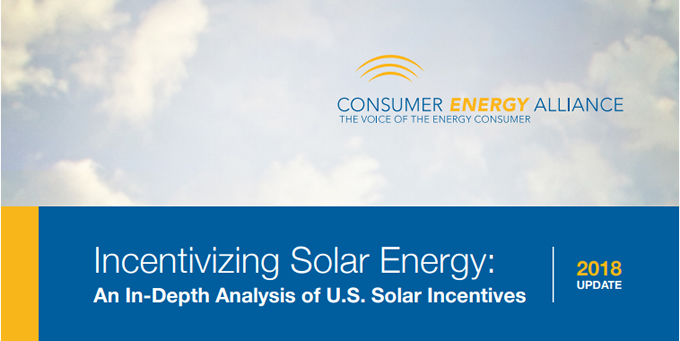CEA Releases 2018 Solar Energy Report; Finds Incentives Contributed Significantly to Solar Power Expansion

As part of Consumer Energy Alliance's (CEA) Solar Energy Future campaign, the organization today released a 2018 update to its 2016 report, "Incentivizing Solar Energy: An In-Depth Analysis of U.S. Solar Incentives." CEA recently commissioned ScottMadden Inc. for this update to provide a comprehensive review and quantification of solar incentives for consumers across multiple states that have greatly contributed to the expansion of solar power across the country.
As part of its "all-of-the-above" approach to meeting our nation's growing energy needs, CEA strongly supports the expanded use of solar power. The consumer group believes that diversifying our energy portfolio and improving options for families and small businesses, will help further reduce energy prices, lower emissions, and enhance our nation’s energy security.
The new report analyzes the cost of a typical solar facility in 25 states and details the federal, state and local incentives available for rooftop solar photovoltaic (PV). It found that:
- Existing incentives for residential PV are significant - In all but five states, direct owners receive at least 75% of total system costs in total incentives under a standard rate structure.
- Utility-scale solar installations are less expensive to install and are incentivized at lower rates per watt than rooftop solar PV systems. Residential solar PV systems receive, on average, between 104% and 140% of total system costs in incentives. Utility-scale solar installations only receive about 45% of total system costs in incentives.
- Third-party-owned solar PV owners receive the most significant incentives. In contrast to direct-owned solar, third-party solar owners are able to generate additional tax benefits through accelerated depreciation.
- Solar PV installation may shift costs to other customers. Net metering programs pay residential PV solar customers full retail rates for their excess electricity production. CEA is concerned this may shift fixed utility infrastructure costs onto non-solar and less affluent customers.
- Incentives for residential solar PV vary widely among the states.
As solar technology continues to reshape modern electricity generation, the number of solar systems in the U.S. has grown rapidly. The 2018 analysis found that in order to accelerate the installation of PV systems, local, state and federal governments have provided several incentive programs for rooftop solar owners. In many states, total incentives are much greater than a solar system's total costs.
The combination of these incentives – along with the substantial declining cost of installing PV systems over the past several years – has led to significant increases in the use of rooftop PV systems across the country. As a result, many states are re-examining the scope and methods surrounding their incentive programs and are now considering programs that rely more on a competitive marketplace to provide the economically optimal levels of rooftop solar adoption.
“Solar energy is an important and growing part of America’s diverse energy mix. We strongly support solar’s growth across the country and we want to ensure that our nation’s solar policies continue to keep pace with the dynamic changes taking place in today’s markets, so that its continued growth is assured," said Brydon Ross, Vice President of State Affairs for CEA. "Solar brings with it tremendous benefits for all consumers.”
Ross added: "Because of the rapid transformations in both the economics of solar PV systems and the policy dialogue over solar incentives in the states, we hope that CEA's updated analysis will help policy makers by quantifying current incentives provided for solar PV systems. By supporting pro-solar, pro-grid and pro-consumer policies, CEA hopes to continue to ensure the proliferation of solar technology, the efficiency of a robust electric grid and increased access to clean, renewable, affordable and reliable energy sources, for all American consumers."
This analysis covers 25 selected states, including: Arizona, Arkansas, California, Colorado, Connecticut, Florida, Georgia, Illinois, Louisiana, Maine, Maryland, Massachusetts, Michigan, Minnesota, Nevada, New Hampshire, New Jersey, New Mexico, North Carolina, Ohio, Oregon, Rhode Island, South Carolina, Texas and Utah. These states were selected to capture diversity in location, state incentive policies, retail tariff designs and wholesale electricity prices.
To review the full results of this analysis and a copy of the report, please click here.
To read the executive summary, please click here.
About Consumer Energy Alliance
Consumer Energy Alliance (CEA) brings together families, farmers, small businesses, distributors, producers and manufacturers to support America's energy future. With more than 500,000 members nationwide, our mission is to help ensure stable prices and energy security for households across the country. We believe energy development is something that touches everyone in our nation, and thus it is necessary for all of us to actively engage in the conversation about how we develop our diverse energy resources and energy's importance to the economy. Learn more at ConsumerEnergyAlliance.org.
Comments (0)
This post does not have any comments. Be the first to leave a comment below.
Featured Product

